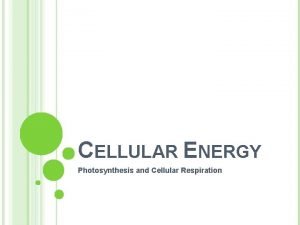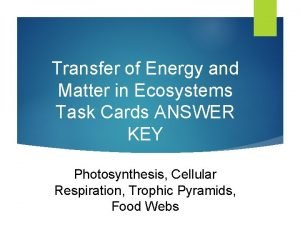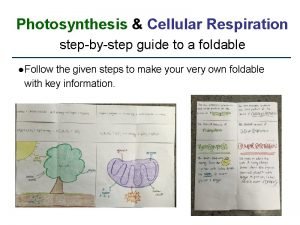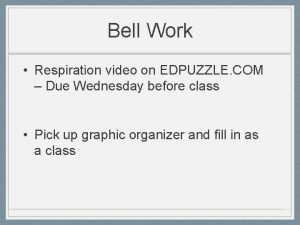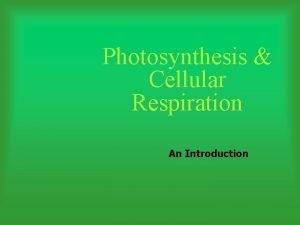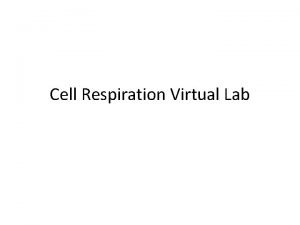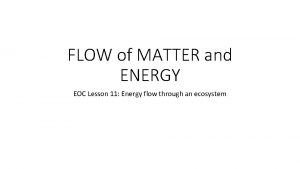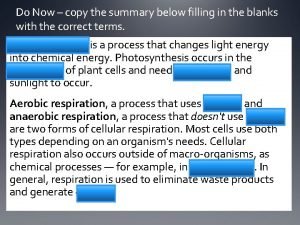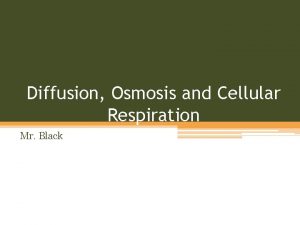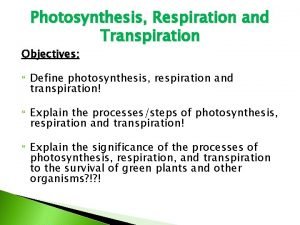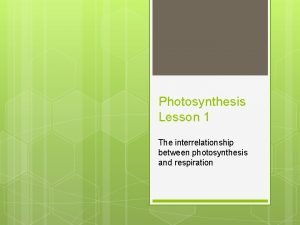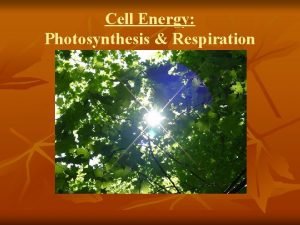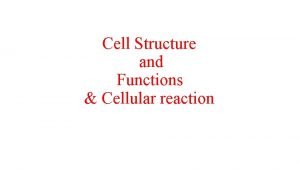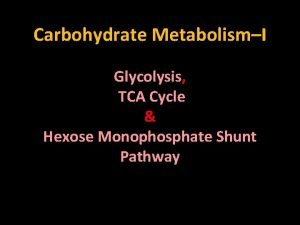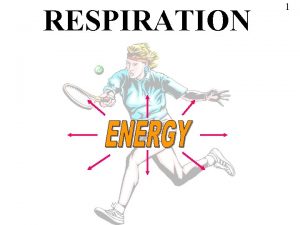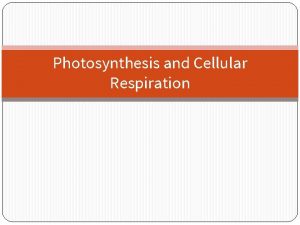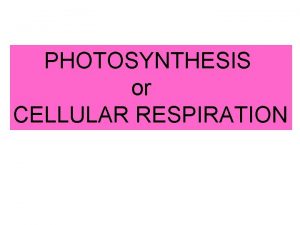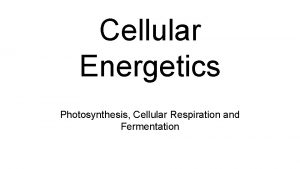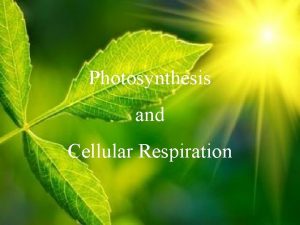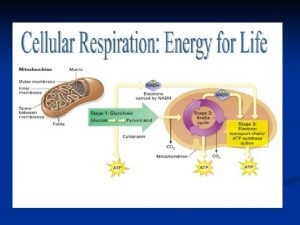DAY 1 Cellular Energetics Photosynthesis and Cellular Respiration






















- Slides: 22

DAY 1 – Cellular Energetics Photosynthesis and Cellular Respiration

Do Now Reteach – Photosynthesis Use the terms below to complete the idea map Trapped by chlorophyll carbon dioxide Sunlight Oxygen Water Sugar Waste useful

Energy and Life Photosynthesis and Cellular Respiration

Take Notes What are we learning today? Benchmark: ü SC. 912. L. 18. 9 – Explain the interrelated nature of photosynthesis and cellular respiration. (AA) ü SC. 912. L. 18. 7 – Identify the reactants, products, and basic functions of photosynthesis. ü SC. 912. L. 18. 10 – Connect the role of adenosine triphosphate (ATP) to energy transfers within a cell. Objectives: ü I will describe the role of ATP in cellular activities. ü I will state the overall equation of photosynthesis and cellular respiration and their interrelated nature.

Take Notes How are photosynthesis and cellular respiration related? The key process for energy capture (from the sun) and storing it as chemical energy in glucose is photosynthesis 6 CO 2 + 6 H 2 O + Light → C 6 H 12 O 6 + 6 O 2 q Takes place in photosynthetic autotrophs only q The energy in glucose (C 6 H 12 O 6) is released during cellular respiration by breaking down glucose and using it to recharge ATP. C 6 H 12 O 6 + 6 O 2 → 6 CO 2 + 6 H 2 O + ATP q Takes place in ALL organisms (Bacteria, Archea, and Eukarya)! q Do you notice that photosynthesis and cellular respiration are opposite reactions? ? !! They form a cycle! q Photosynthesis captures and saves energy. (makes Food) q Cellular respiration releases and uses the energy. (eat Food) q

Exergonic or Exothermic Endergonic or Endothermic Reactants Products C 6 H 12 O 6 + 6 O 2 → 6 CO 2 + 6 H 2 O + ATP Atmosphere Sun Makes muscles work Neurons work Heart work 6 CO 2 + 6 H 2 O + Light → C 6 H 12 O 6 + 6 O 2 Lose the rest as heat to the environment Glucose (food) Notice the sun’s energy enters photosynthesis and is stored in glucose… Animals eat the glucose and use the energy stored by the plants to recharge ATP… we use ATP to run everything in our bodies…ultimately the energy in ATP is used and release as heat… Energy flows… one way Notice that plants take in CO 2 from the atmosphere … make glucose with it… animals eat glucose and release the carbon back into the atmosphere as carbon dioxide … where the plants can use it again… Elements(matter) cycle through the ecosystem

Do Now Reteach – Leaf Structure We’ve learned in class that a leaf’s structure is optimized for absorbing light and carrying out photosynthesis Label the parts of the leaf and describe their function in relation to photosynthesis

Take Notes How do organisms use energy? One of the principal compounds that cells use to store and release energy is adenosine triphosphate, or ATP. q ATP consists of q Adenine (1) q Ribose (1) q Phosphate groups (3) q Advantages of ATP: q q Stored so that it can be released when needed q Stored in small packages so that the cell can use small quantities as required. q Stores chemical energy in a useful form

Take Notes What is the ATP-ADP cycle? q Adenosine diphosphate, or ADP, looks like ATP except that it has two phosphate groups instead of three. q If a cell wants to store small amounts of energy, it can add a phosphate group to ADP molecules producing ATP. q If the cell needs energy, it breaks the bond between the 2 nd and 3 rd phosphate.

Take Notes What are the most important chemical reactions on Earth? q Photosynthesis is the process by which some organisms capture the energy of sunlight and convert it to chemical energy that is stored as food q Cellular respiration is the process by which all organisms obtain energy from the chemical bonds in food molecules. q Both photosynthesis and cellular respiration are cellular processes.

Take Notes What is cellular respiration? q Both plants and animals cells carry out the final stages of cellular respiration in the mitochondria. q Cellular respiration is the process that releases energy by breaking down glucose and other food molecules in the presence of O 2. 6 O 2 + C 6 H 12 O 6 6 CO 2 + 6 H 2 O + Energy

Take Notes What is glycolysis? q Glycolysis is the process in which one molecule of glucose is broken in half, producing two molecules of pyruvic acid, a 3 -carbon compound q Takes place in the cytoplasm q Takes 1 glucose (C 6 H 12 O 6) and makes 2 pyruvates or pyruvic acids q This pyruvate still contains some energy from the glucose molecule. q Uses 2 ATP molecules to make 4 ATP molecules

Take Notes What happens during aerobic respiration? Pyruvic acid must be transported into the mitochondria. In the mitochondria, pyruvic acid is turned into acetyl-Co. A. Acetyl-Co. A produced enters the Kreb’s Cycle, a process that releases CO 2 and H+ AND produces ATP. q At the end of the Kreb’s cycle q 2 ATP are produced. q CO 2 is released q H+ are released q These H+ pass through the inner compartment to the outer compartment of the mitochondria where they combine with O 2 to form H 2 O. q ATP is produced as hydrogen ions diffuse into the inner compartment. q Up to 38 ATP can be produced q q q

Summary Cellular respiration begins in the cytoplasm (glycolysis) Glucose is broken down (energy released) No oxygen required Only a small amount of ATP produced. The products of glycolysis enters the mitochondria, where cellular respiration is completed. Requires oxygen. A great amount of ATP is made from ADP. CO 2 and H 2 O are waste products.

Energy and Life Types of Cellular Respiration

DAY 2 – Cellular Energetics Aerobic and Anaerobic Cellular Respiration

Take Notes What are we learning today? Benchmark: ü SC. 912. L. 18. 8 – Identify the reactants, products, and basic functions of aerobic and anaerobic cellular respiration. Objectives: I will identify the reactants and products of aerobic and anaerobic respiration ü I will state the functions of aerobic and anaerobic respiration ü

Take Notes q What are the two types of cellular respiration? There are two types of cellular respiration q Anaerobic (without oxygen) pathways q Aerobic (with oxygen) pathways q Both pathways begin with glycolysis q Glycoq -lysis relating to glucose the act of cutting

Take Notes What happens during anaerobic respiration? q Occurs in the ABSENCE of oxygen. q Pyruvate or pyruvic acid from glycolysis enters anaerobic fermentation. q Less energy is released q 2 main types of fermentation: q Lactic Acid Fermentation q Alcoholic Fermentation

Take Notes What is alcoholic fermentation? q Yeast, a single-celled fungus. q Pyruvate is broken down into: q CO 2 is released q Causes bread dough to rise q Causes carbonation in some alcoholic beverages q Ethanol is produced q Wine and beer contain ethanol made from yeast

Take Notes What is lactic fermentation? Produced in your muscles during rapid exercise q Occurs when O 2 supply is short because blood can’t reach muscles quickly to deliver enough O 2 q Allows glycolysis to continue producing ATP for as long as the glucose supply lasts. q Pyruvate is converted to lactic acid or lactate causing sore muscles q

Which Is It? Work It Out Use the terms below to complete the Venn diagram comparing ANAEROBIC and AEROBIC cellular respiration Efficient Inefficient 38 ATP 2 ATP Requires glucose Generate energy Occurs in cytoplasm and mitochondria Occurs only in cytoplasm release CO 2 uses Oxygen Doesn’t use oxygen Kreb’s cycle Begin with glycolysis Involve pyruvic acid Fermentation of alcohol or lactic acid Does not produce water
 Complimentary processes
Complimentary processes Photosythesis equation
Photosythesis equation Summary equation for cellular respiration
Summary equation for cellular respiration Cellular respiration equation
Cellular respiration equation Where does cellular respiration take place
Where does cellular respiration take place Photosynthesis and cellular respiration foldable
Photosynthesis and cellular respiration foldable Edpuzzle cellular respiration
Edpuzzle cellular respiration The chemical process of photosynthesis
The chemical process of photosynthesis Cellular respiration virtual lab snails and elodea
Cellular respiration virtual lab snails and elodea Photosynthesis and cellular respiration jeopardy
Photosynthesis and cellular respiration jeopardy Photosynthesis or cellular respiration
Photosynthesis or cellular respiration Day 1 day 2 day 3 day 4
Day 1 day 2 day 3 day 4 Venn diagram photosynthesis and respiration
Venn diagram photosynthesis and respiration Venn diagram photosynthesis and respiration
Venn diagram photosynthesis and respiration Photosynthesis define
Photosynthesis define Interrelationship between photosynthesis and respiration
Interrelationship between photosynthesis and respiration How do plants get glucose
How do plants get glucose Cellular respiration flocabulary read and respond answers
Cellular respiration flocabulary read and respond answers External respiration
External respiration External respiration vs internal respiration
External respiration vs internal respiration Photosynthesis vs. respiration
Photosynthesis vs. respiration Day 1 day 2 day 817
Day 1 day 2 day 817 Hmp significance
Hmp significance



